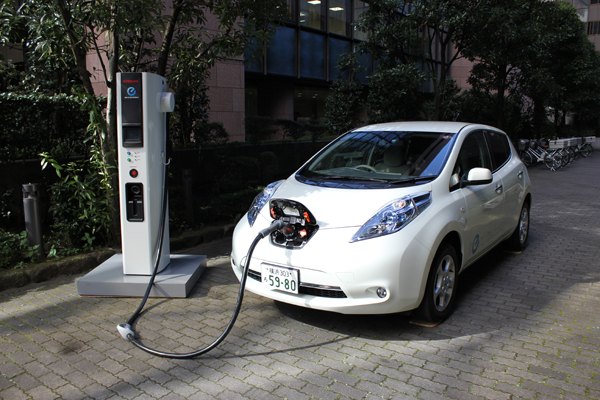Nissan Quickcharger: Half The Size At Half The Price

If you want to charge your Nissan Leaf in 30 minutes, Nissan will (at least in Japan) sell you (reluctantly) a pricy quickcharger. It costs about half of what a U.S. Leaf costs – before incentives and rebates: The current quickcharger sets you back 1.47 million yen, in today’s dollars, that’s about $19,000. Soon, this will get considerably, well, more reasonable. Nissan today announced a quickcharger with the same performance, but at half the size and half the price of the old one.
According to an emailed statement by Nissan, “the newly-developed quick charging unit retains the high performance of the current quick charger manufactured by Nissan,” but will “take up less space and enable easier installation.” A final price is not set. However, Nissan says that the unit will “cost significantly less than one million yen,” and “the base specification unit will cost only below one half the price of the current unit.” That would be around $8.500 – in Japan, including tax.
The new unit complies with the CHAdeMO protocol and is rated at a hefty 49kW at “3- AC200V” (which I assume means 200V 3phase). It produces 500V DC at 125 Amps. Apart from the base unit, a (pricier) outdoor unit and one for cold climes are available. All share the same electrical specs.
Still, the quickcharger is not expected to be a fast moving item. Nissan aims to sell 5,000 of the new quick chargers by March 2016 (!!!). The target market is Nissan dealerships, local government facilities and “locations that draw large numbers of customers in regions throughout Japan.”
The U.S. and Europe will get the charger at some point. Given high enough quantities, the price can drop considerably . A DC welder with similar ratings can be had for less that $1,000.

Bertel Schmitt comes back to journalism after taking a 35 year break in advertising and marketing. He ran and owned advertising agencies in Duesseldorf, Germany, and New York City. Volkswagen A.G. was Bertel's most important corporate account. Schmitt's advertising and marketing career touched many corners of the industry with a special focus on automotive products and services. Since 2004, he lives in Japan and China with his wife <a href="http://www.tomokoandbertel.com"> Tomoko </a>. Bertel Schmitt is a founding board member of the <a href="http://www.offshoresuperseries.com"> Offshore Super Series </a>, an American offshore powerboat racing organization. He is co-owner of the racing team Typhoon.
More by Bertel Schmitt
Latest Car Reviews
Read moreLatest Product Reviews
Read moreRecent Comments
- ToolGuy I do like the fuel economy of a 6-cylinder engine. 😉
- Carson D I'd go with the RAV4. It will last forever, and someone will pay you for it if you ever lose your survival instincts.
- THX1136 A less expensive EV would make it more attractive. For the record, I've never purchased a brand new vehicle as I have never been able to afford anything but used. I think the same would apply to an EV. I also tend to keep a vehicle way longer than most folks do - 10+ years. If there was a more affordable one right now then other things come to bear. There are currently no chargers in my immediate area (town of 16K). I don't know if I can afford to install the necessary electrical service to put one in my car port right now either. Other than all that, I would want to buy what I like from a cosmetic standpoint. That would be a Charger EV which, right now, doesn't exist and I couldn't afford anyway. I would not buy an EV just to be buying an EV. Nothing against them either. Most of my constraints are purely financial being 71 with a disabled wife and on a fixed income.
- ToolGuy Two more thoughts, ok three:a) Will this affordable EV have expressive C/D pillars, detailing on the rocker panels and many many things happening around the headlamps? Asking for a friend.b) Will this affordable EV have interior soft touch plastics and materials lifted directly from a European luxury sedan? Because if it does not, the automotive journalists are going to mention it and that will definitely spoil my purchase decision.c) Whatever the nominal range is, I need it to be 2 miles more, otherwise no deal. (+2 rule is iterative)
- Zerofoo No.My wife has worked from home for a decade and I have worked from home post-covid. My commute is a drive back and forth to the airport a few times a year. My every-day predictable commute has gone away and so has my need for a charge at home commuter car.During my most recent trip I rented a PHEV. Avis didn't bother to charge it, and my newly renovated hotel does not have chargers on the property. I'm not sure why rental fleet buyers buy plug-in vehicles.Charging infrastructure is a chicken and egg problem that will not be solved any time soon.


































Comments
Join the conversation
"A DC welder with similar ratings can be had for less that $1,000." That remark either shows your ignorance of how lithium battery chargers work, or is meant to be a shocking point of comparison. A 'smart' charger contains a lot more than a rectifying diode and some wiring, particularly at these power levels. You have to monitor numerous parameters to achieve a proper and safe charge, while providing feedback to the customer about state of charge, errors, and other desirables. As for quick-charging, that is an exceptionally bad practice for lithium batteries, and I'm surprised Nissan will stand by the warranty of a car subjected to it.
Sounds like a perfect item for outside of casual restaurants or Starbucks. Pull up, bide your time and change while you wait.